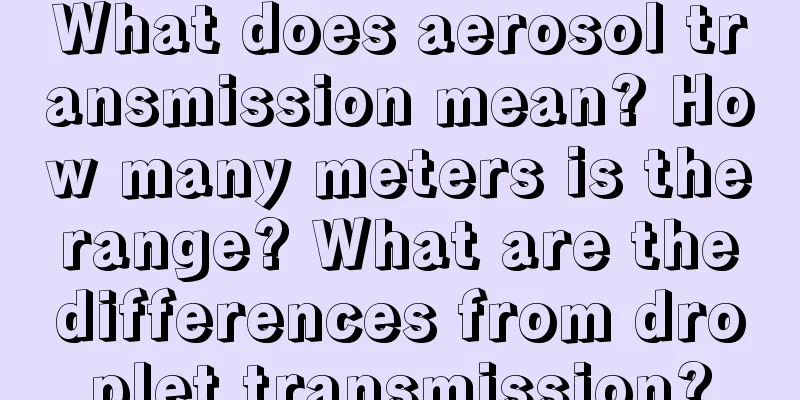What does aerosol transmission mean? How many meters is the range? What are the differences from droplet transmission?

| Droplet transmission, contact transmission, and aerosol transmission are the three common transmission routes of COVID-19. At noon on April 10, the Ningbo Center for Disease Control and Prevention issued a notice that an incident suspected to be caused by aerosol transmission occurred in this round of epidemic in Ningbo. So, what does aerosol transmission mean? How many meters is the range? What are the differences from droplet transmission? 1. What does aerosol transmission mean? Aerosol transmission refers to the pathogen nuclei left behind by droplets while suspended in the air. These droplet nuclei float to distant places in solid or liquid form to spread and infect. Simply put, aerosol transmission refers to droplets mixing in the air to form aerosols, which cause infection after inhalation. 2. How many meters is the aerosol transmission range? The propagation distance of aerosols can reach tens or even hundreds of meters, which is mainly related to the type of microorganisms and the environment. In an environment with air convection, the aerosol will float with the air, and its propagation path and distance will be expanded. If it is in a closed environment, the concentration of aerosols will increase, which will make the human body more susceptible to infection. Therefore, the transmission distance is not only related to the aerosol mode, but also to the virus load and environmental circulation. 3. What are the differences between aerosol transmission and droplet transmission? 1. Different key solutes The key solute for droplet transmission is droplets, and the key solute for aerosol transmission is droplet nucleus, that is, the nucleus composed of protein and pathogens. 2. The volume of solutes is different. The volume of droplet transmission is larger, while the volume of aerosol transmission is smaller and lighter. 3. Different transmission distances: The transmission distance of droplet transmission is generally 1-2 meters, and it will not float in the air for a long time. Aerosol transmission can float with the wind, and the risk of transmission still exists within the range of 1-2 meters. 4. Different concentrations: The concentration of droplet transmission is higher, and the concentration of aerosol transmission is lower. 5. Different transmission conditions: Droplet transmission occurs when talking, coughing, or sneezing, while aerosol transmission mainly occurs in confined spaces, such as airplanes, elevators, cinemas, and other places with poor air flow. When ventilation conditions improve and the virus is diluted to a certain extent, the risk will naturally decrease. In general, although the new coronavirus can be transmitted through aerosols, don't worry too much. It can be prevented by wearing a mask correctly and washing hands frequently during daily travel. |
<<: Perfect Diary’s secret to live streaming on Tik Tok!
>>: Analysis of the effectiveness of LV’s live broadcast on Xiaohongshu!
Recommend
The user just left and left, leaving me alone in the mess of the App!
What is the reason why users leave without saying...
Can drinking "magic liquid" before a physical test really improve your physical fitness?
Recently, the media interviewed me: I heard that ...
Teacher Qi's "Brick and Mortar Store Douyin Account Traffic Growth Operation Course"
Teacher Qi's "Physical Store Douyin Acco...
IEA: Review of US Energy Policy in 2024
The IEA released the "2024 U.S. Energy Polic...
Two-year study reveals big problems for Android
[[268883]] A study conducted over a two-year peri...
Beware of flash floods! Two departments jointly issue orange flash flood disaster weather warning
The Ministry of Water Resources and the China Met...
How can Douyin's massive Qianchuan investment boost the traffic of Douyin's live broadcast room?
Juliang Qianchuan has also launched a number of t...
The methodology for launching hot-selling products on Douyin!
In July, a super skin care product quickly became...
Some Misunderstandings about MVC/MVP/MVVM
Using MVP and MVVM patterns in Android developmen...
The advent of the era of "technological renaissance" has led to the final polarization of BAT
The Wuzhen World Internet Conference is an offici...
Don’t be fooled by my short tail, I’m very powerful when hunting!
This is a kitten with eye-catching whiskers on it...
Why does Xiaomi make air purifiers?
A few days ago, Lei Jun announced on his Weibo th...
How did the leader in the field of superchargeable batteries come to be? Uncovering the secret of Juwan Technology Research's killer weapon
On November 17, the 21st Guangzhou International ...
7 essential skills for operators: Three communication skills to improve your operational efficiency (Part 4)
Without adequate communication, even the best ope...
Fourth in the world! He led the team to conquer chlortetracycline and broke the US monopoly
In January 1956, the CPC Central Committee decide...









